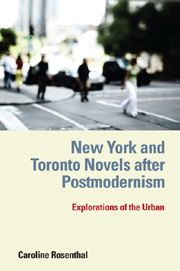Book contents
- Frontmatter
- Contents
- Preface and Acknowledgments
- Introduction
- 1 Imagining National Space: Symbolic Landscapes and National Canons
- 2 Articulating Urban Space: Spatial Politics and Difference
- 3 “The Inadequacy of Symbolic Surfaces”: Urban Space, Art, and Corporeality in Siri Hustvedt's What I Loved
- 4 Rewriting the Melting Pot: Paule Marshall's Brownstone City in The Fisher King
- 5 Specular Images: Sub/Urban Spaces and “Echoes of Art” in Carol Shields's Unless
- 6 “The End of Traceable Beginnings”: Poetics of Urban Longing and Belonging in Dionne Brand's What We All Long For
- 7 Synthesis
- Bibliography
- Index
3 - “The Inadequacy of Symbolic Surfaces”: Urban Space, Art, and Corporeality in Siri Hustvedt's What I Loved
Published online by Cambridge University Press: 12 September 2012
- Frontmatter
- Contents
- Preface and Acknowledgments
- Introduction
- 1 Imagining National Space: Symbolic Landscapes and National Canons
- 2 Articulating Urban Space: Spatial Politics and Difference
- 3 “The Inadequacy of Symbolic Surfaces”: Urban Space, Art, and Corporeality in Siri Hustvedt's What I Loved
- 4 Rewriting the Melting Pot: Paule Marshall's Brownstone City in The Fisher King
- 5 Specular Images: Sub/Urban Spaces and “Echoes of Art” in Carol Shields's Unless
- 6 “The End of Traceable Beginnings”: Poetics of Urban Longing and Belonging in Dionne Brand's What We All Long For
- 7 Synthesis
- Bibliography
- Index
Summary
A surface separates inside from out and belongs no less to one than the other.
— Don DeLillo, CosmopolisNew York City, taken as image and symbol, has long stood as a revealing paradigm of the American character; as New York City is seen, so is registered each era's degree of faith in the promise of American life.
— Shaun O'Connell, Remarkable, Unspeakable New YorkSiri Hustvedt's 2003 novelWHAT I LOVED is set in the vibrant art scene of New York City and investigates “the glory of urban freedom and indifference.” The urban space of New York is represented as offering a myriad of possibilities for inventing and reinventing personal identity. While such an abundance of options is portrayed as liberating on the one hand, the novel also points out the potential violence such supposedly limitless opportunities harbor. What I Loved resonates with myths of New York as the Big Apple — a city of superlatives in economic and artistic ways, a city where “anything goes” and where norms and laws can be overruled, and a city where national myths such as the notion of American Exceptionalism or the rags-to-riches myth flourish. Hustvedt's novel portrays New York as exciting and inspiring but at the same time shows that the perpetual hunger for something new, more exciting, or more spectacular causes a “regeneration through violence,” as Slotkin puts it. Just as the idea of Manifest Destiny, the West, or the frontier not only opened up new realms and possibilities but also caused violence and destruction, Hustvedt's text points out how the mythologically charged space of New York makes but also breaks people.
- Type
- Chapter
- Information
- New York and Toronto Novels after PostmodernismExplorations of the Urban, pp. 73 - 122Publisher: Boydell & BrewerPrint publication year: 2011

